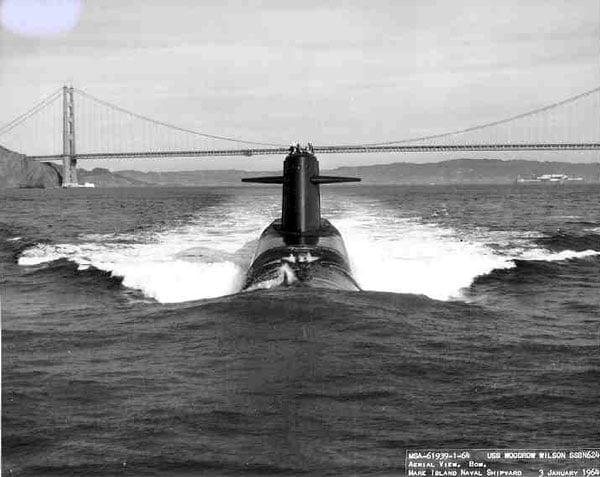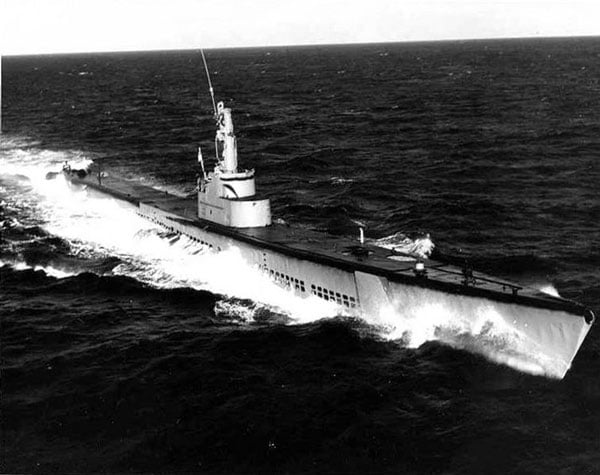
USS Woodrow Wilson, ballistic missile submarine
In a recent interview, Sgt. 1st Class Bruce Lipe, who retired in 2009 after 41 years of collective service between the Navy and the National Guard, shared what it was like to be part of a submarine crew during the Vietnam War. While his days were not spent tromping through thick jungles, but rather hidden in the depths of the Pacific Ocean, he still faced a unique set of challenges while contributing service. The biggest of those challenges? Isolation and communication.
His entire time of service was spent aboard four different submarines (see photos), each with a specific function. The types of submarines included ballistic missile subs, fast attack subs and a patrol gun boat that was assigned to the coastal surveillance group.
His deployment during the Vietnam War was what was referred to as WESTPAC, which covers the area of the western Pacific Ocean and Southeast Asia. Each deployment lasted three to four months and most, if not all, of that time was spent under water within the submarine. Which, of course, meant that for those months under water, the crew was unable to see or feel any sunlight.

USS Daniel Webster, ballistic missile submarine
Those that were aboard submarines had to not only be able to perform their own duties and responsibilities, but also had to have an understanding and working knowledge of other jobs on the vessel. In the event that others were not able to perform their regular jobs, the remaining members of the crew had to be able to fill those positions. The inability to carry out a job may be due to the individual, such as sickness or injury, or it may be the result of other circumstances, such as flooding, in which event certain areas of the vessel would be sealed off, making it impossible to rotate work areas.
The submarine community is relatively small compared with the rest of the surface Navy, and the camaraderie within the submarine community is uniquely its own. While the brotherly bond is strong, as it is in within any military unit, residing within the depths of the ocean for several months at a time with only about 100 people in a 33-foot diameter metal tube, the bond can be distinctive. And there’s an understanding of challenges they all face in such conditions, an understanding which carries over even once back on land.

USS Queenfish, fast attack sub
Due to the nature of the environment, the psychological and other screenings required to be stationed on a submarine are much more in depth, as adverse reactions, such as claustrophobia and paranoia, are much more likely to occur. In addition, one of the biggest challenges faced by those stationed on submarines is the effect of isolation.
During the time of the Vietnam War, communications on submarines were slow and unreliable at best. Sailors were allowed to receive communication through familygrams, a 25 to 50 word message. They could receive these messages, but not send any. Another problem was that family members sending the familygrams had no way of knowing whether or not the message was received. Oftentimes, those aboard the submarine would have to wait to receive news of any kind until surfacing, which could be up to four months later. Obviously, technology has since changed and communications are much improved aboard submarines.

USS Antelope, patrol gun boat
Lipe then goes on to talk about the attitude surrounding the Vietnam War, describing it as “an unpopular time.” For the most part, soldiers were not looked upon as heroes. They were ridiculed and insulted, called horrific names and spat upon. Many soldiers were warned to change out of uniform immediately upon returning home, as Lipe explains, they “were not welcomed by the American people,” and for the most part were made to feel as if they had done something wrong for being a part of the war, regardless of the part that they played. He recalls a time when he came home on sick leave and was spit on in the airport. There was much animosity present and soldiers were often told, more or less, to just “suck it up and drive on.” And Lipe shares that that’s exactly what he did, keeping all of the emotions of the war bottled up inside for years.
With different times came different wars, and it wasn’t until many years later, during Desert Storm, that those emotions were released. Seeing the support of the American people for the soldiers during that time was the beginning of healing the emotional hurt from the Vietnam era. And some say, including Lipe’s wife, that the American people felt an obligation to treat those soldiers with the love and support that they so bitterly lacked during Vietnam.
Even those who were not deployed were still involved in the welcome home parades of Desert Storm and that’s when Lipe was truly able to let go of the negativity he had felt since Vietnam. He explains that he was reluctant to be involved, but nonetheless was. “When we crossed the Broadway Bridge over the Arkansas River and saw the crowds that had come out, lined up as far as you could see, and eight, 10, 12 people deep… a lot of those feelings were released.” Continuing on, the more recent events of 9/11 has molded the American public’s view, and the soldiers are once again getting the respect that they deserve.
He then goes on to talk about the outpouring of support that the soldier’s would receive, not only upon returning, but any time they were out and about in uniform. This was a support that the soldiers in Vietnam lacked. He spoke of taking flights and being moved to first class and going to pay for a meal in a restaurant, only to find that someone had already paid for it.

The author on her wedding day with her father, Bruce Lipe.
Average Americans can feel respect and support for today’s soldiers, but often don’t know how to show it. Other than supporting organizations that strive to help vets, they are unaware how to show that they care. Sometimes the smallest gestures can mean the most, so the next time you’re out and see a soldier in uniform, pay for their meal, or just simply take the time to shake their hand and say, “Thank you for your service.”





